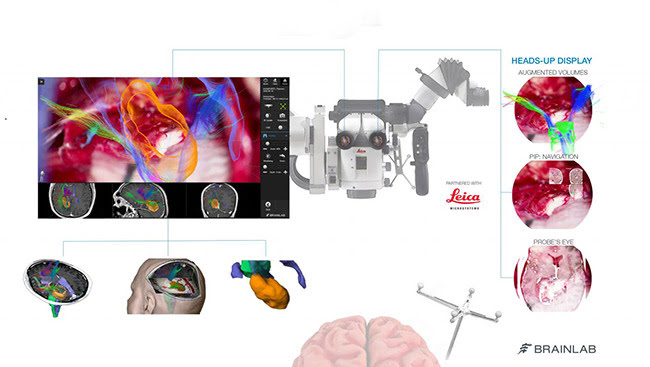
Virtual Reality May Offer Advances in Microscope Imaging
A novel microscope image injection system has demonstrated the ability to relay virtual reality imaging to a surgeon through an eyepiece, known as the ocular, during microscopic surgery. The system, named CaptiView, allows images to be superimposed into the surgeon’s eyepiece and projects a heads-up display into the eyepiece while the surgeon is operating. The heads-up display provides neurovascular and fiber-track information in 2D or 3D as well as the on-screen video overlays visible through the ocular.

CaptiView overlays critical virtual reality imaging directly onto
the brain when viewed through the eyepiece, known as the ocular, during
surgery. Courtesy of Mount Sinai Health System.
The surgeon can track the focal point of the CaptiView ocular; and because the surgeon is always looking through the ocular, the CaptiView can follow wherever the physician is looking. This feature, known as microscope integration, can provide the surgeon with greater spatial visual awareness during surgery. Microscope integration also allows the surgeon to switch views in the eyepiece, toggling between live and pre-operative anatomical images using handle control buttons or footswitch. Markers attached to the microscope enable positional tracking and autofocus.
The CaptiView utilizes Brainlab Cranial 3.1 Navigation Software in conjunction with a Leica M530 OH6 microscope.
"This next-generation augmented virtual reality tool provides real-time information in ways never before realized," said Joshua Bederson, M.D., professor and system chair for the Department of Neurosurgery at Mount Sinai Health System.
The CaptiView may be an indicator of a future in which computer-rendered 3D scenarios will be brought into the operating environment to augment the actual surgery.
"We are driving and advancing the development of next-generation simulation and virtual reality technology, which can help improve patient outcomes and solve neurosurgical challenges," said Bederson, who worked closely with Leica Microsystems and Brainlab to develop the surgical navigation tool.
Joshua Bederson, M.D., utilizes the latest simulation and virtual reality advances during neurosurgery. Courtesy of Mount Sinai Health System.
Published: September 2016